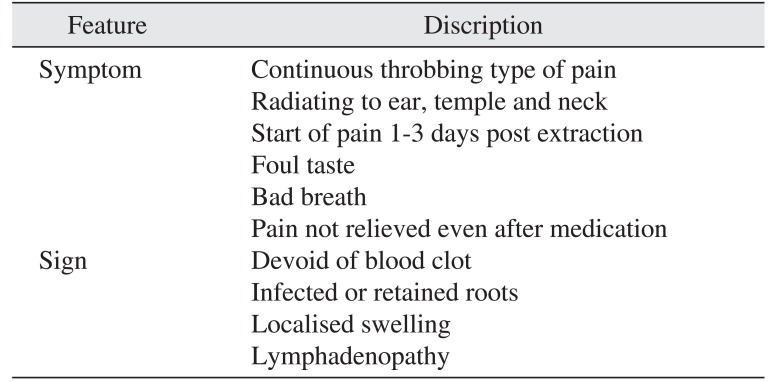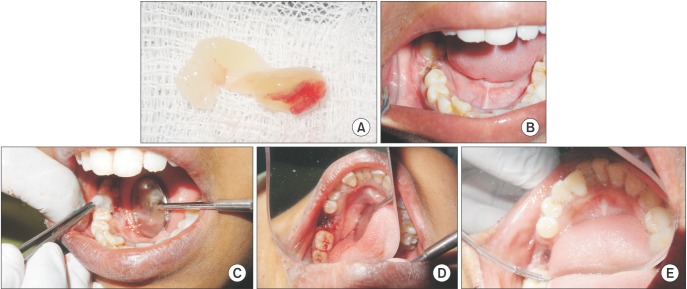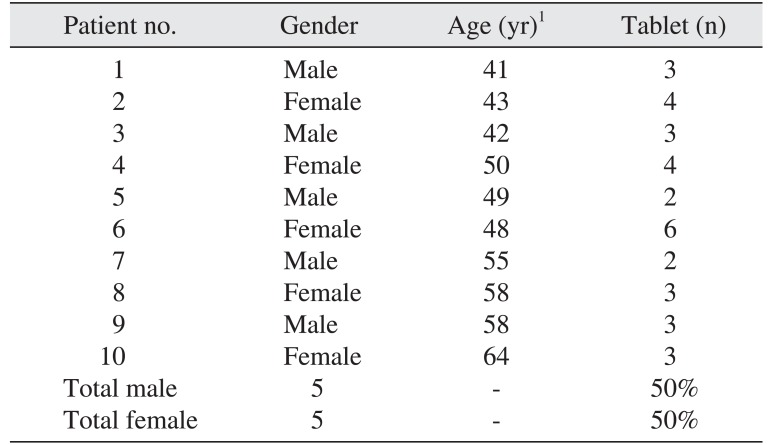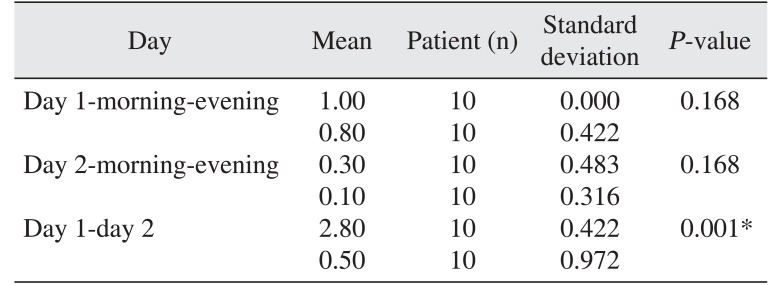1. Daly B, Sharif MO, Newton T, Jones K, Worthington HV. Local interventions for the management of alveolar osteitis (dry socket). Cochrane Database Syst Rev. 2012; 12:CD006968. PMID:
23235637.

2. Fridrich KL, Olson RA. Alveolar osteitis following surgical removal of mandibular third molars. Anesth Prog. 1990; 37:32–41. PMID:
2077984.
3. Blum IR. Contemporary views on dry socket (alveolar osteitis): a clinical appraisal of standardization, aetiopathogenesis and management: a critical review. Int J Oral Maxillofac Surg. 2002; 31:309–317. PMID:
12190139.

4. Vezeau PJ. Dental extraction wound management: medicating postextraction sockets. J Oral Maxillofac Surg. 2000; 58:531–537. PMID:
10800909.

5. Caso A, Hung LK, Beirne OR. Prevention of alveolar osteitis with chlorhexidine: a meta-analytic review. Oral Surg Oral Med Oral Pathol Oral Radiol Endod. 2005; 99:155–159. PMID:
15660084.

6. Garcia AG, Grana PM, Sampedro FG, Diago MP, Rey JM. Does oral contraceptive use affect the incidence of complications after extraction of a mandibular third molar? Br Dent J. 2003; 194:453–455. discussion 445. PMID:
12778101.

7. Muhonen A, Ventä I, Ylipaavalniemi P. Factors predisposing to postoperative complications related to wisdom tooth surgery among university students. J Am Coll Health. 1997; 46:39–42. PMID:
9248241.

8. Noroozi AR, Philbert RF. Modern concepts in understanding and management of the “dry socket” syndrome: comprehensive review of the literature. Oral Surg Oral Med Oral Pathol Oral Radiol Endod. 2009; 107:30–35. PMID:
18755610.

9. Bloomer CR. Straws do not cause dry sockets when third molars are extracted. Tex Dent J. 2012; 129:25–32. PMID:
22432232.
10. Reekie D, Downes P, Devlin CV, Nixon GM, Devlin H. The prevention of ‘dry socket’ with topical metronidazole in general dental practice. Br Dent J. 2006; 200:210–213. discussion 206; quiz 226. PMID:
16501533.

11. Kaya GŞ, Yapici G, Savaş Z, Güngörmüş M. Comparison of alvogyl, SaliCept patch, and low-level laser therapy in the management of alveolar osteitis. J Oral Maxillofac Surg. 2011; 69:1571–1577. PMID:
21398006.

12. Jovanović G, Urić N, Krunić N, Tijanić M, Stojanović S. Assessment of the effectiveness of low level laser in the treatment of alveolar osteitis. Vojnosanit Pregl. 2011; 68:506–510. PMID:
21818918.

13. Pal US, Singh BP, Verma V. Comparative evaluation of zinc oxide eugenol versus gelatin sponge soaked in plasma rich in growth factor in the treatment of dry socket: an initial study. Contemp Clin Dent. 2013; 4:37–41. PMID:
23853450.

14. Haraji A, Lassemi E, Motamedi MH, Alavi M, Adibnejad S. Effect of plasma rich in growth factors on alveolar osteitis. Natl J Maxillofac Surg. 2012; 3:38–41. PMID:
23251056.

15. Singh V, Pal US, Singh R, Soni N. Honey a sweet approach to alveolar osteitis: a study. Natl J Maxillofac Surg. 2014; 5:31–34. PMID:
25298714.

16. Martínez-Zapata MJ, Martí-Carvajal A, Solà I, Bolibar I, Angel Expósito J, Rodriguez L, et al. Efficacy and safety of the use of autologous plasma rich in platelets for tissue regeneration: a systematic review. Transfusion. 2009; 49:44–56. PMID:
18954394.

17. Anitua E, Orive G. Use of PRGF to accelerate bone and soft tissue regeneration in postextraction sites. Implant Dialogue. 2003; 36:3–14.
18. Alexander RE. Dental extraction wound management: a case against medicating postextraction sockets. J Oral Maxillofac Surg. 2000; 58:538–551. PMID:
10800910.

19. Plachokova AS, Nikolidakis D, Mulder J, Jansen JA, Creugers NH. Effect of platelet-rich plasma on bone regeneration in dentistry: a systematic review. Clin Oral Implants Res. 2008; 19:539–545. PMID:
18422984.

20. Aldecoa EA, Ortiz IA. A mew approach to bone regeneration: plasma rich in growth factors. Vitoria: Puesta al Dia Publicaciones;2001. p. 172.
21. Sammartino G, Tia M, Marenzi G, di Lauro AE, D'Agostino E, Claudio PP. Use of autologous platelet-rich plasma (PRP) in periodontal defect treatment after extraction of impacted mandibular third molars. J Oral Maxillofac Surg. 2005; 63:766–770. PMID:
15944972.

22. Simon D, Manuel S, Geetha V, Naik BR. Potential for osseous regeneration of platelet-rich plasma--a comparative study in mandibular third molar sockets. Indian J Dent Res. 2004; 15:133–136. PMID:
16035641.
23. Mozzati M, Martinasso G, Pol R, Polastri C, Cristiano A, Muzio G, et al. The impact of plasma rich in growth factors on clinical and biological factors involved in healing processes after third molar extraction. J Biomed Mater Res A. 2010; 95:741–746. PMID:
20725982.

24. Rutkowski JL, Johnson DA, Radio NM, Fennell JW. Platelet rich plasma to facilitate wound healing following tooth extraction. J Oral Implantol. 2010; 36:11–23. PMID:
20218866.

25. Song JY, Kweon H, Kwon KJ, Park YW, Kim SG. The bone regenerative effect of silk fibroin mixed with platelet-rich fibrin (PRF) in the calvaria defect of rabbit. J Korean Assoc Oral Maxillofac Surg. 2010; 36:250–254.

26. Halberstein RA, Abrahmsohn GM. Clinical management and control of alveolalgia (“dry socket”) with vitamin C. Am J Dent. 2003; 16:152–154. PMID:
12967066.
27. Burgoyne CC, Giglio JA, Reese SE, Sima AP, Laskin DM. The efficacy of a topical anesthetic gel in the relief of pain associated with localized alveolar osteitis. J Oral Maxillofac Surg. 2010; 68:144–148. PMID:
20006169.

28. Faizel S, Thomas S, Yuvaraj V, Prabhu S, Tripathi G. Comparision between neocone, alvogyl and zinc oxide eugenol packing for the treatment of dry socket: a double blind randomised control trial. J Maxillofac Oral Surg. 2015; 14:312–320. PMID:
26028852.

29. Rani A, Mohanty S, Sharma P, Dabas J. Comparative evaluation of Er:Cr:YSGG, diode laser and alvogyl in the management of alveolar osteitis: a prospective randomized clinical study. J Maxillofac Oral Surg. 2016; 15:349–354. PMID:
27752206.

30. Haghighat A, Bahri Najafi R, Bazvand M, Badrian H, Khalighinejad N, Goroohi H. The effectiveness of GECB pastille in reducing complications of dry socket syndrome. Int J Dent. 2012; 2012:587461. PMID:
22577382.

31. Taberner-Vallverdú M, Nazir M, Sánchez-Garcés MÁ, Gay-Escoda C. Efficacy of different methods used for dry socket management: a systematic review. Med Oral Patol Oral Cir Bucal. 2015; 20:e633–e639. PMID:
26116842.
32. Kolokythas A, Olech E, Miloro M. Alveolar osteitis: a comprehensive review of concepts and controversies. Int J Dent. 2010; 2010:249073. PMID:
20652078.

33. Sharif MO, Dawoud BE, Tsichlaki A, Yates JM. Interventions for the prevention of dry socket: an evidence-based update. Br Dent J. 2014; 217:27–30. PMID:
25012325.

34. Torres-Lagares D, Serrera-Figallo MA, Romero-Ruíz MM, Infante-Cossío P, García-Calderón M, Gutiérrez-Pérez JL. Update on dry socket: a review of the literature. Med Oral Patol Oral Cir Bucal. 2005; 10:81–85. PMID:
15627911.
35. Fazakerley M, Field EA. Dry socket: a painful post-extraction complication (a review). Dent Update. 1991; 18:31–34. PMID:
1936428.
36. Cardoso CL, Rodrigues MT, Ferreira Júnior O, Garlet GP, de Carvalho PS. Clinical concepts of dry socket. J Oral Maxillofac Surg. 2010; 68:1922–1932. PMID:
20537783.










 PDF
PDF ePub
ePub Citation
Citation Print
Print





 XML Download
XML Download